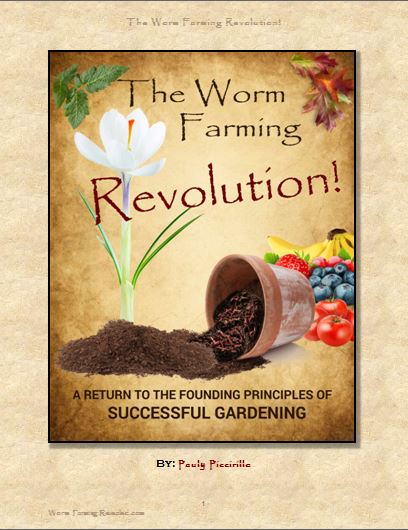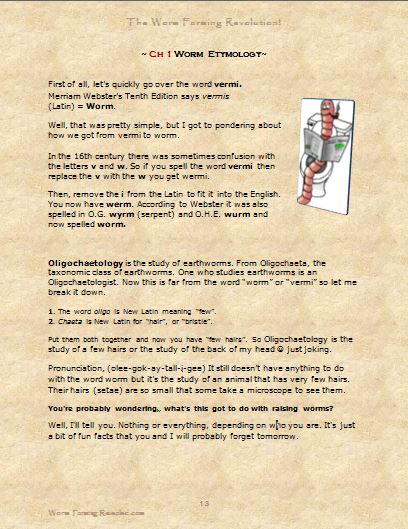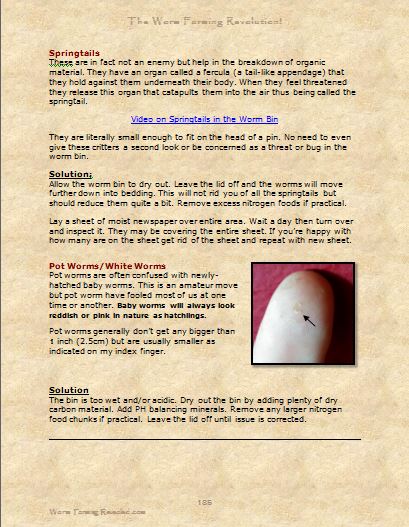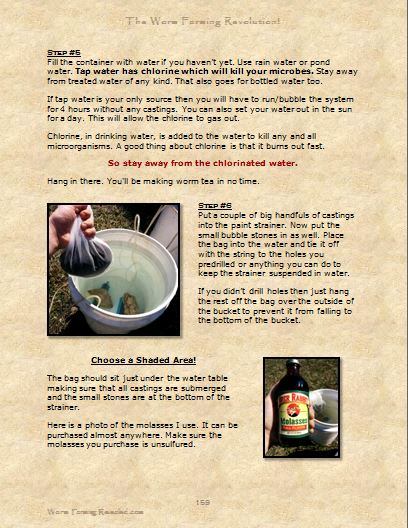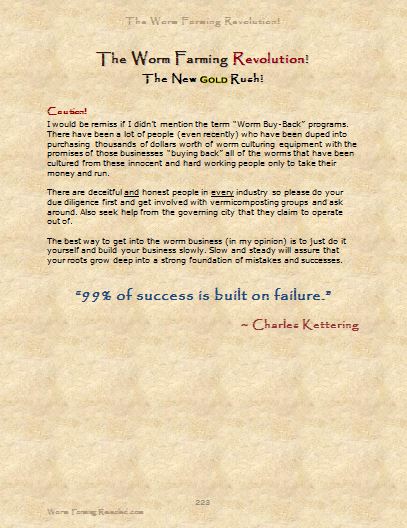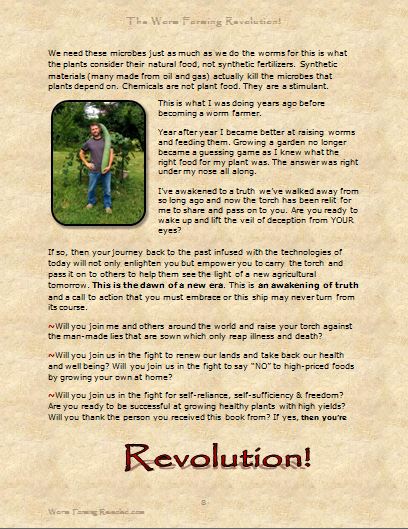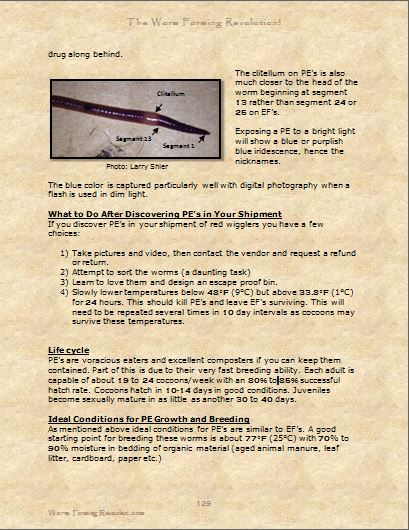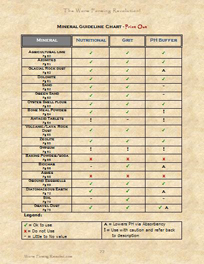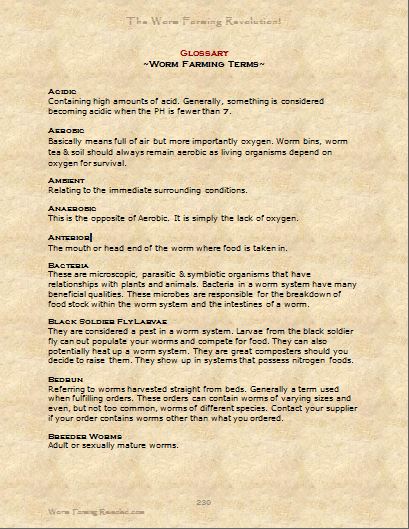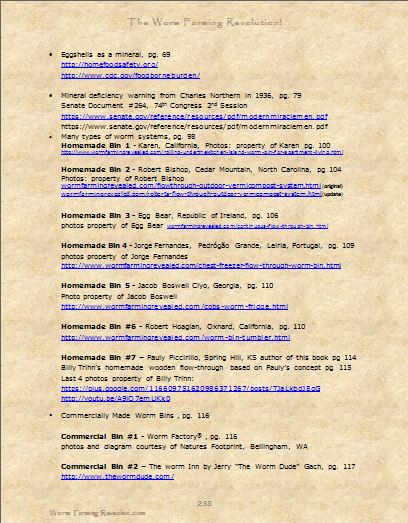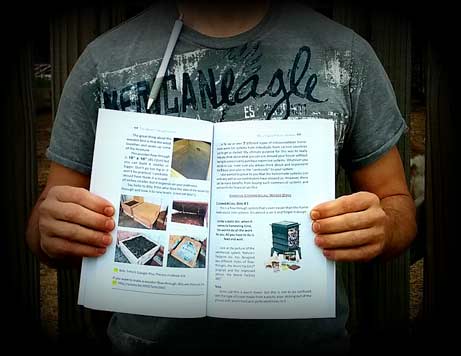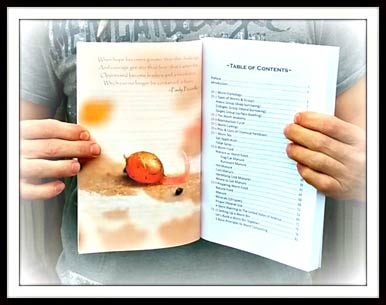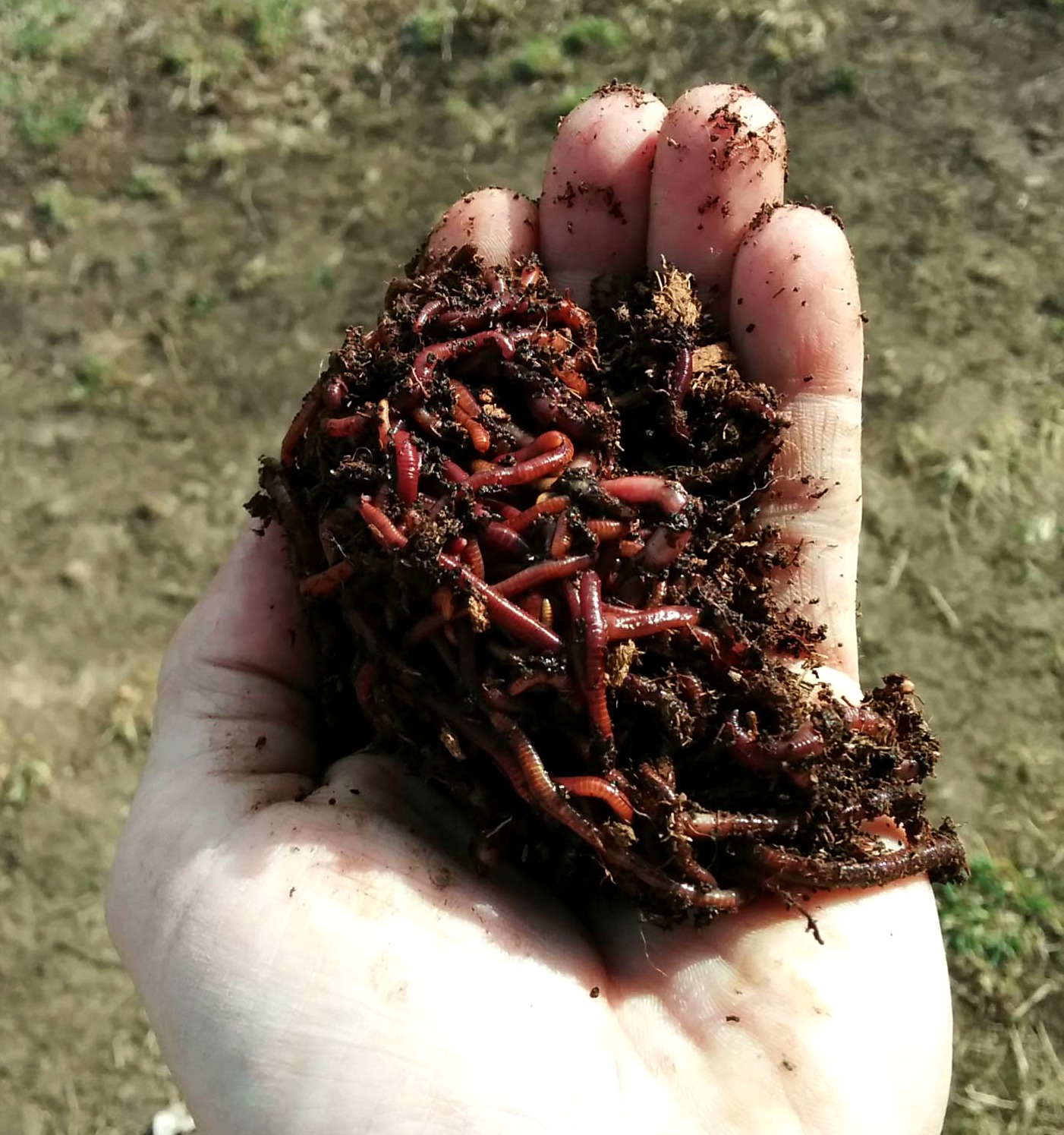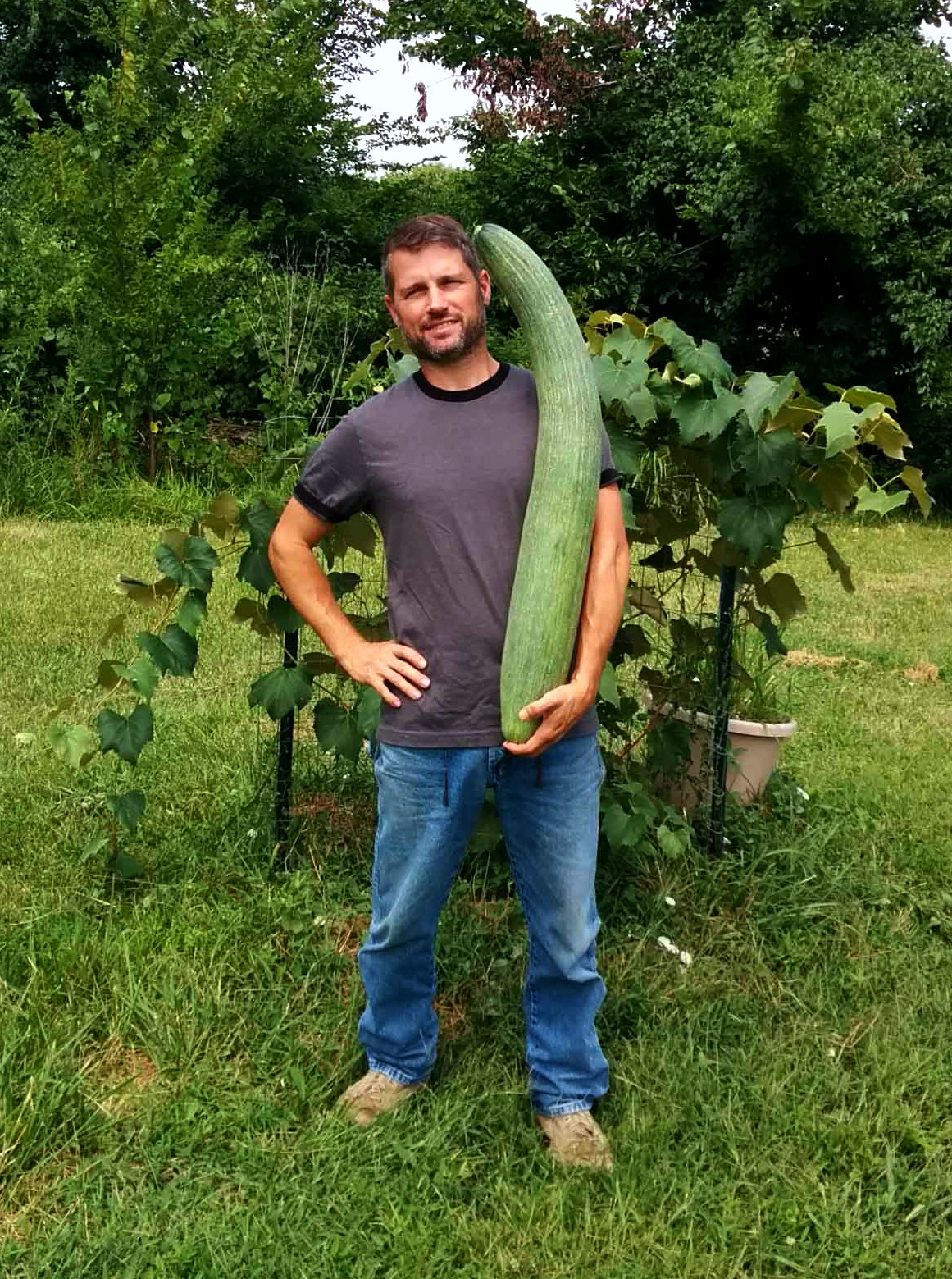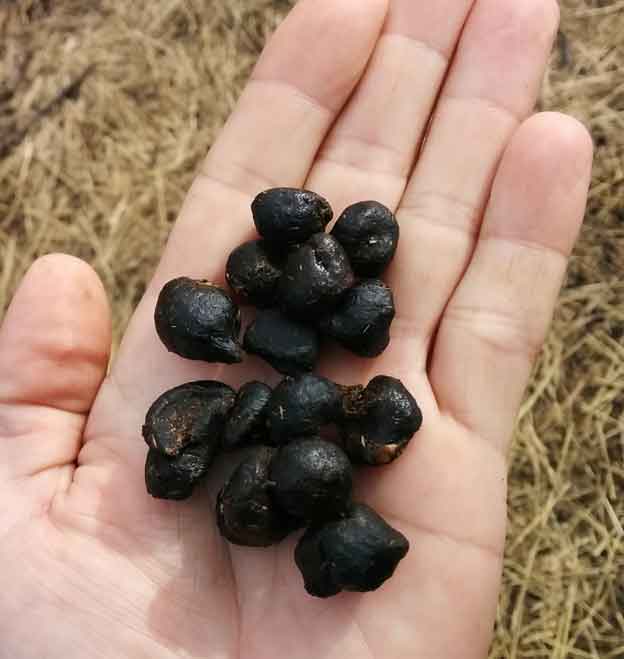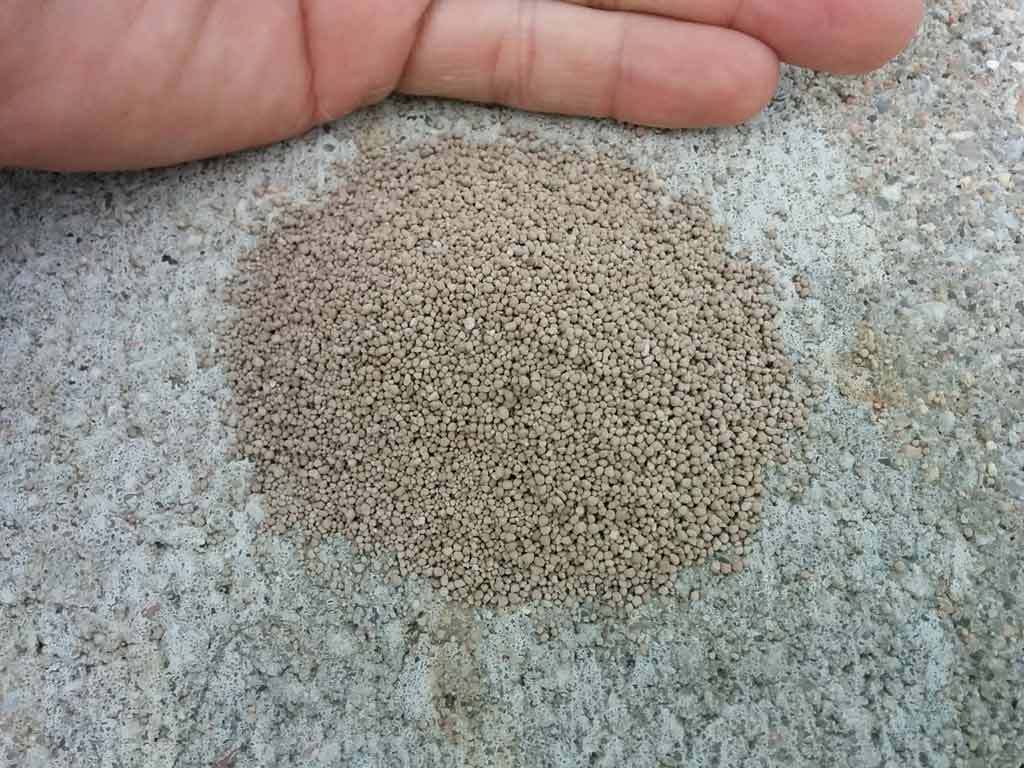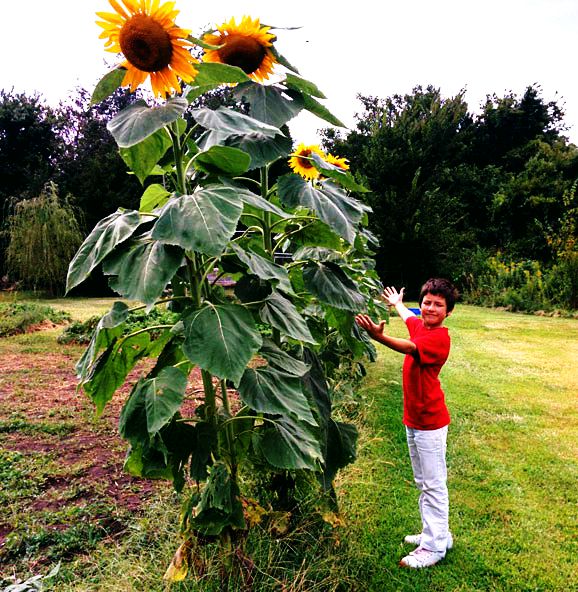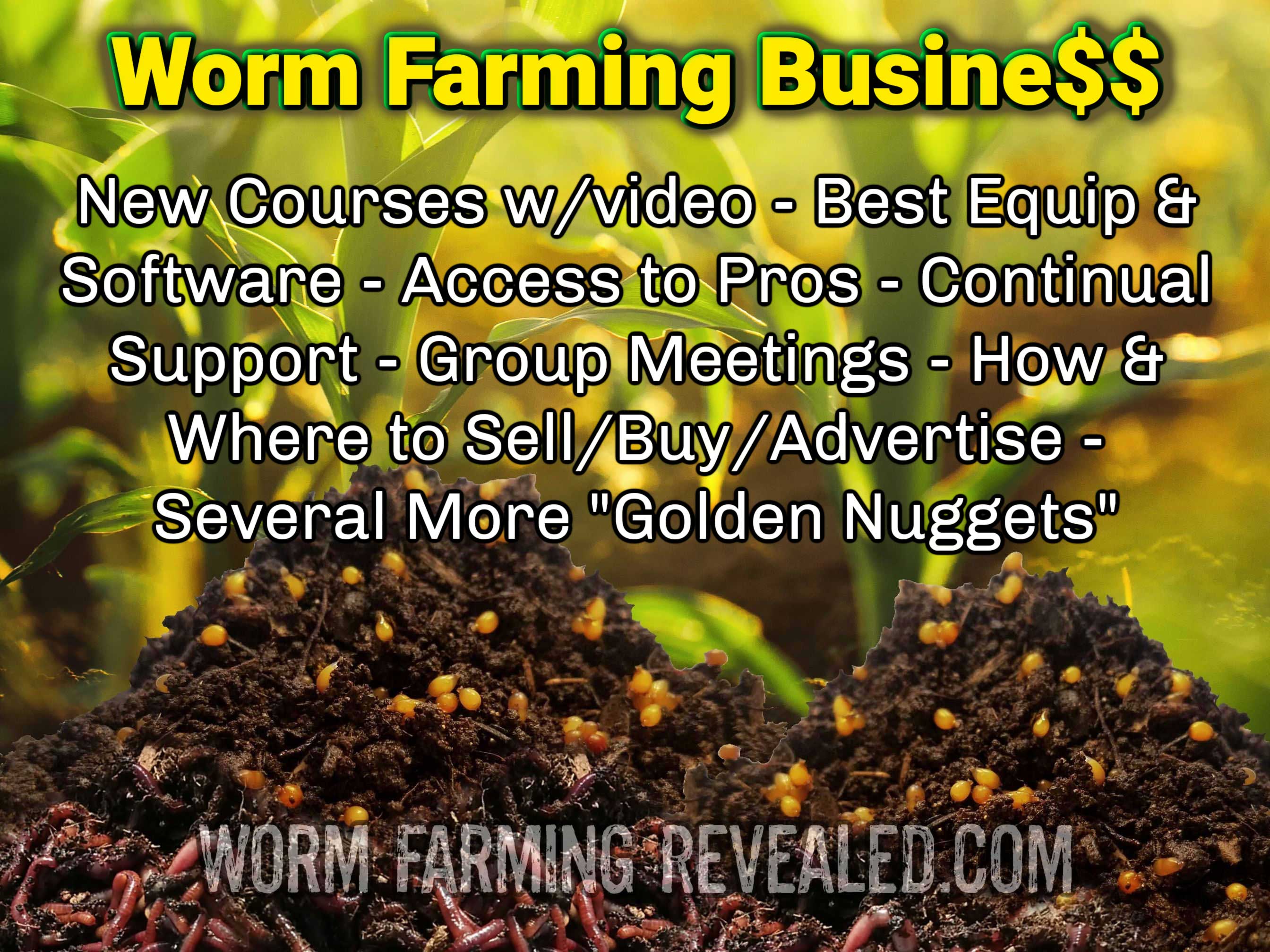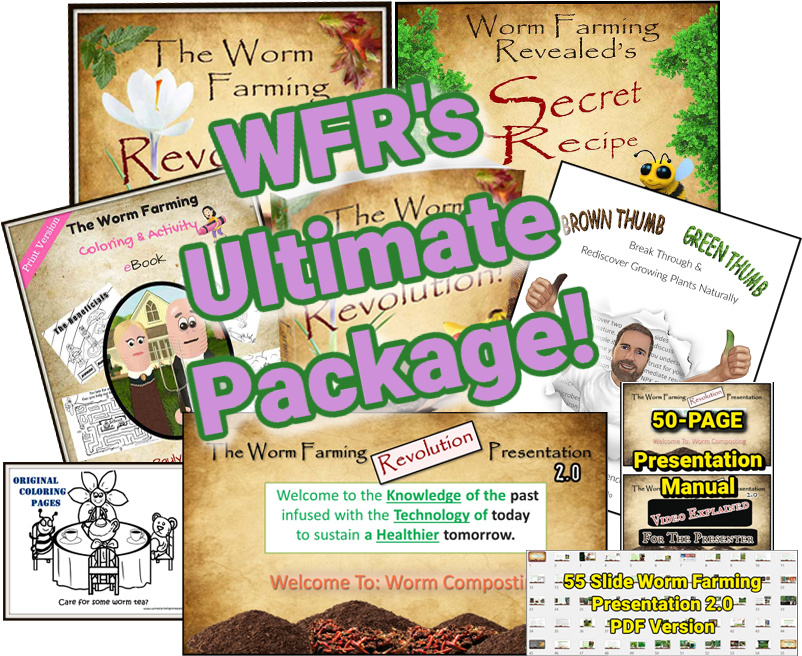The Worm Farming Revolution Book Preview
Below is The Worm Farming Revolution Book preview. Read the preface along with several other pages.
This book is full of images, inspirational quotes, charts, definitions of common worm farming terms, and most of all practical and useful information written in an engaging format that never rabbit trails or worm holes ;)
Purchase & Read the Book Today!
Look Inside The eBook!
|
Cover Preface 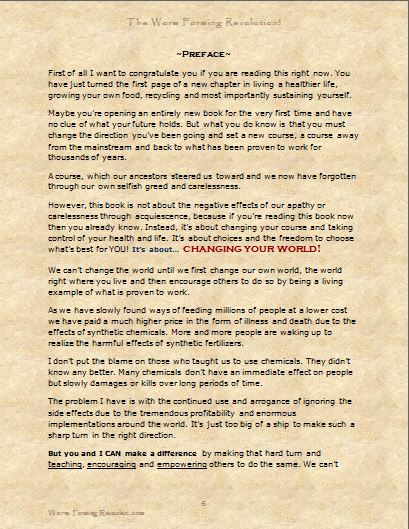 Etymology Other Worm Bin Aerated Worm Tea The New Gold Rush |
Preface Worm Anatomy 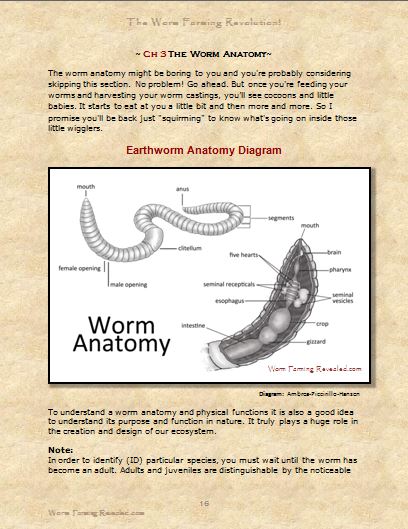 Blue Worms Safe Minerals Glossary of Terms Outbound Links |
And Much More...
Look Inside the Paperback Book!
Table of Contents
Preface
Introduction
Ch1 Etymology
Ch2 Types of Worms & Groups
Anecic
Endogeic
Epigeic
Ch3 The Anatomy
Ch4 Reproduction Cycle
Ch5 Worm Castings
Ch6 Pros & Cons of Chemical Fertilizers
Ch7 Worm Tea
Soil
Application
Foliar
Spray
Ch8 Worm Food
Manure
Dog/Cat Manure
Ruminant
Manure
Hot
manure
Cold
manure
Identifying
Cold Manures
Where
to Get Manure
Ch9 Preparing Worm Food
Natural
Feed
Manure
Minerals
(19 types)
Proper
Mineral Use
A
Stern Warning to the USA
Ch10 Setting up A Worm Bin
Let’s Build A Worm
Bin Together
5
Basic Principles to Worm Composting
Choosing a Location
Outside Systems
Indoor Systems
Ch11 Many Types of Worm Systems
Static
System
Flow-Through
System
Continuous
Flow-Through System
Various
Homemade Worm Bins
Bin Systems 1-7
Various
Commercial Systems
Bin Systems 1-5
Ch12 Worm Species
Red Wiggler, Eisenia Fetida
European Nightcrawler, Eisenia
Hortensis
Blue Worm, Perionyx Excavatus
African Nightcrawler, Eudrilus
Eugeniae
Canadian Nightcrawler, Lumbricus
Terrestris
Alabama Jumper, Amynthus Gracilus
Choosing the Right Species
Ch13 Worm Farming in the Winter
Natural Heat
Insulation
Types of Bins for Winter
Ch14 Leachate vs Worm Tea
What is Leachate
What is Worm Tea
Using Leachate Properly
Ch15 How to Make Worm Tea
Video Tutorial Links
Text Tutorial
Ch16 Harvesting worm
Castings
From a Static Bin
From a Flow-Through
From a Continuous Flow-Through
Ch17 How to Use Worm
Castings
In Landscaping and Gardens
In Seed Rows
In Starter Pots
Mixing Ratios
In Lawns
Ch18 Storing Worm Castings
Storing Indoors
Storing Outdoors
Ch19 Working With Other Organisms in the Worm
Bin
Common Friendly Organisms, cause &
Solutions
Common Unwanted Pests, cause & solutions
Ch20 Worm Facts
Ch21 Worm Farming - The New Gold Rush Case Studies of
“Real”
People with “Real” Worm Businesses
Cases 1-3
Timeout - Make Money in 6 Different
Fields of Vermicomposting
Cases
4-6
Helpful
Print Outs In the back and
throughout
Mineral Guideline Chart (19 minerals)
A 5-Step Approach to Any Successful
Worm Bin
Worm Quick-Pick Easy Selection Guide
Worm Facts
Foods To Avoid In A Worm System
Fat Worm Recipe
Growth Rates & Reproduction
Cycles of Common Composting Worms
Glossary
Worm Farming Terms
References & Attributes
Coloring Pages for Kids (Separate free download below)
Purchase & Read the Book Today!
Preface Pgs 6-8
First of all I want to congratulate you if you are reading this right now. You have just turned the first page of a new chapter in living a healthier life, growing your own food, recycling and most importantly, sustaining yourself.
Maybe you’re opening an entirely new book for the very first time and have no clue of what your future holds. But what you do know is that you must change the direction you’ve been going and set a new course, a course away from the mainstream and back to what has been proven to work for thousands of years.
A course, which our ancestors steered us toward and we now have forgotten through our own selfish greed and carelessness.
However, this book is not about the negative effects of our apathy or carelessness through acquiescence, because if you’re reading this book now then you already know. Instead, it’s about changing your course and taking control of your health and life. It’s about choices and the freedom to choose what’s best for YOU! It’s about… changing your world!
We can’t change the world until we first change our own world, the world right where you live and then encourage others to do so by being a living example of what is proven to work.
As we have slowly found ways of feeding millions of people at a lower cost we have paid a much higher price in the form of illness and death due to the effects of synthetic chemicals. More and more people are waking up to realize the harmful effects of synthetic fertilizers.
I don’t put the blame on those who taught us to use chemicals. They didn’t know any better. Many chemicals don’t have an immediate effect on people but slowly damages or kills over long periods of time.
The problem I have is with the continued use and arrogance of ignoring the side effects due to the tremendous profitability and enormous implementations around the world. It’s just too big of a ship to make such a sharp turn in the right direction.
But you and I CAN make a difference
by making that hard turn and teaching, encouraging and empowering others to do the same. We can’t dwell on the negative thinking but must act positively and do something in our own lives.
We must go from synthetic thinking to organic doing,
until one day that ship will be able to make that full turn. I see it already happening in my life and in others. Many are already waking up to embrace the lost knowledge of our forefathers.
There’s an awakening going on all over the world. It’s a fusion of technology with the knowledge of the past. It’s a course set in the right direction and a course we never should have abandoned but embraced and improved upon.
Years ago I’ve awakened to this forgotten blueprint of agricultural success when the so-called “technological advancements” failed me. I knew there had to be a better way for me and my family, because I was nearly burnt-out and quite frankly, so were my plants.
Through diligent research and a call to action I began to put the ancient theories to the test. Every living thing in life has a purpose whether good or bad…I only needed to harness their potential benefits.
What were these beneficial living creatures…?
|
Worms! They’re
everywhere! Because plants are everywhere, or should I say, plants are everywhere because worms are everywhere. They have a unique coexistence between each other. |
As the plant dies and falls to the ground special microorganisms break down the decaying plant. The worms then eat the microbes.
This is where the miracle happens, in the gut of a worm. Special bacteria in the worm feed on the bacteria that ate the decaying matter. The worms expel a very complex microorganism that no other creature can duplicate. These special microbes are worm castings (worm poop) that smell just like natural earth.
We need these microbes just as much as we do the worms for this is what the plants consider their natural food, not synthetic fertilizers. Synthetic materials (many made from oil and gas) actually kill the microbes that plants depend on. Chemicals are not plant food. They are a stimulant.
|
This is what I was doing years ago before becoming a worm farmer. Year after year I became better at raising worms and feeding them. Growing a garden no longer became a guessing game as I knew what the right food for my plant was. The answer was right under my nose all along.
|
I’ve awakened to a truth we’ve walked away from so long ago and now the torch has been re-lit for me to share and pass on to you. Are you ready to wake up and lift the veil of deception from your eyes?
If so then your journey back to the past infused with the technologies of today will not only enlighten you but empower you to carry the torch and pass it on to others to help them see the light of a new agricultural tomorrow. This is the dawn of a new era. This is an awakening of truth and a call to action that you must embrace or this ship may never turn from its course.
~Will you join me and others around the world and raise your torch against the man-made lies that are sown which only reap illness and death?
~Will you join us in the fight to renew our lands and take back our health and well being and join us in the fight to say no to high-priced foods by growing your own at home?
~Will you join us in the fight for self-reliance, self-sufficiency & freedom? Are you ready to be successful at growing healthy plants with high yields? Will you thank the person you received this book from? If yes, then you’re ready to join…
Introduction Pgs 9-12
So why am I a worm farmer? I told my family that I didn't want to be remembered as a worm farmer. I mean, how glorious is that? Instead, I’d rather be remembered for helping others find a way to live a healthier life. But it all starts somewhere.
Gardens don’t "just" happen.
You can't simply sow a seed and expect to reap bountiful fruit without the proper knowledge of how to care for it and that all starts with the soil. But soil doesn’t just happen either.
Even the soil has its beginnings and that starts with a tiny little creature known as...the worm, “A gardener’s best friend”.
We
all live in a continuous perpetual world that’s constantly revolving and
renewing itself every single day. The health of a plant starts at its roots, in
the soil. Healthy soil is lively and teaming with trillions of microorganisms
all harmonizing together. But where do all of these tiny organisms come from?
They come from the gut of a worm and the worm received its nutrition from, once
again, a plant that has run its cycle.
Out of all of these living organisms, who deserves the credit? The plant, the microbes, or the worm? What about us? Where do we fit into this equation?
Well, the truth is…We Don’t.
Plant’s, microbes, and worms existed long before we ever did. They were well orchestrated by a Conductor who knew exactly what He was doing thousands of years ago. They didn’t need us to help them become something they already were and they definitely didn’t need us to make them into something they weren’t created to be.
No! Instead, we were created to merely benefit from this perpetual blessing set into motion so long ago. Just like little kids playing jump rope, we only need to…“step in”.
When we all can learn how to step in and follow the motion already set into play instead of recreating something that only goes against the grand design, will we finally realize a longer, healthier, and richer life is waiting for us each and every day.
If you want to change your life for the better then all you need to do is “step in”. So maybe it does start somewhere and maybe that somewhere starts with…….You!
I guess this is why I’m a worm farmer.
This book will teach you just about everything you’ll ever need to know about raising composting worms but Hold On! This book is more than just about raising worms.
It’ll teach you that worms are the master soil builders in order for plants to have the best foundation for growth, health and yields. Worms are like master brick layers. They lay the building blocks that are so crucial for a great foundation like that of the great pyramids.
This book teaches you how to be successful with plants because…
If you can get the soil right
then you will get the plant right!
More introduction in the book...
Chapter 8 pgs - Worm Food (excerpt talking about manure)
1.
Herbivores that Ruminate (multi-chambered
stomach)
There are more than 150 of these animals but here’s a small
list.
(List removed for preview)
2.
Herbivores that do not Ruminate (mono-gastric/non-ruminating)
(List removed for preview)
3. Omnivores Domesticated (but mostly plant eating)
(List removed for preview)
|
All manures from the animals listed above (and I’m sure there are a few more) are safe to use in the worm bin as worm feed. Although there is one caveat I must mention. You need to know which manures should be pre-composted at least a good 2 weeks before introducing it to your worms. |
You may be asking yourself,
“Doesn’t all manure have to be pre-composted before giving it to the worms”? Good News! NO!
There are two types of manure when considering to precompost or not when feeding it to your worms.
HOT manure COLD manure
Now, I have never fed my worms manure from many animals listed above but many of my readers have and visitors to the website have. When you look on the Internet for the definitions of “hot” and “cold” manure you get quite a few opposing interpretations.
Here are the differences.
Hot manure contains higher levels of nitrogen/ammonia. Cows, horses, pigs, poultry, etc… are such animals and their manure should be hot or pre-composted before introducing it to the worms. Hot composting is called a thermophilic process. A thermophile is a microbe that thrives in temperatures between 106 and 252 °F (41 and 122 °C).
If you feed your worms the fresh “hot manure” then the chances of the worm bin becoming increasingly too warm for the worms will prove to be detrimental thus you risk killing off your squirm.
In traditional hot compost piles there will be some loss of nutrients during the whole hot process. After the pile cools, the temperature becomes more like the ambient air and a different type of bacteria begin to populate. The cold process now begins. This would also be the time to feed it to the worms if this is your goal.
Don’t be concerned about
the loss of nutrients. Many people put too much focus on N-P-K ratios rather than microbial count.
I’ll give you my thoughts on this later in the book.
Cold manure contains less nitrogen. Rabbits, goat, sheep, deer etc… are such animals. As a matter of fact, their manure is considered stable enough to feed directly to your garden or plants in moderation of course. The microbes break down the foods for the worms and a worm bin rarely gets warm. Vermicomposting is cold composting and is called a mesophilic process.
These organisms are called mesophiles. They populate in temperatures 68 - 113°F (20-45 °C). When composting between these temperatures it is known as a mesophilic process. These are the microbes that populate after temperatures have cooled in a hot compost pile.
I must add a qualifier though to cold manure. If the animal was fed a balanced diet of small amounts of grain compared to the fiber it eats then you’re pretty safe.
I have goats of my own and feed their poop directly into my plants every year with only positive results but I’m the one who feeds them too. More so than not I’d say your chances are pretty safe. After all, who in their right mind would feed half or more grain than necessary? Grain is not cheap!
However, I always caution
people before feeding manure directly to the worms. Anytime cold manure is
not composted first, whether in a hot compost pile or given to the worms, you
take the risk of sending unwanted weed seeds and insects into your worm bin or
garden. I speak from experience.
Here’s another thought to
consider. When using fresh manure of any kind to fertilize newly planted seeds,
you run the risk of having little insects (certain beetles) burrowing into the
nutritional seed pod. Fresh manure contains seeds that attract insects. Again,
I speak from experience.
I feed goat manure to composting worms directly to my indoor worm bins. It’s not always fed straight from the butt-to-the-gut. I let it sit in a bucket to stabilize for a week or so. It doesn’t get hot but some moisture does evaporate.
Cold manure can heat when gathered in large
quantities and maintained properly, but not likely in smaller amounts in a worm
bin.
Caution!
If you bring in any
material from outside sources like manure, leaves, compost, etc… You will also be
bringing in unwanted pests & seeds. There’s nothing worse than a house full
of outside creatures.
There’s an easy way to direct-feed manure to your worms indoors.
If you plan on feeding manure or anything from outside to your indoor worms then you’ll definitely want to see my 3 part video on
(Removed for Preview)
Video 1 Video 2 Video 3
Some people actually do feed their worms fresh manure from the butt-to-the-worm-gut but this is usually in outside piles or under rabbit cages etc. Almost anything is possible in worm farming but worms that arrive in the mail from another place is a different scenario.
That’s because you are changing their diet and it takes a little while for them to adjust to the new food source. Interestingly, when worms are hatched into any food source they tend to do much better than their predecessors.
This is because they never knew any other type of food, but more importantly the bacteria inside of them never knew any other type of food. Most people do not understand this theory. We recently discussed how the rumen of an animal is full of beneficial bacteria, but not just any kind of bacteria. It’s a special type that breaks down tough fiber like hay or grass.
When I feed my goats too much grain, or even too much grain for the first time, they become sick. It takes a special kind of bacteria to digest the grains. Their rumens were full of bacteria that only broke down hay. Now they must wait until they can build up enough of the right kind of bacteria to break down the grain.
In the meantime they’ll be very uncomfortable and bloated as the food just sits rotting in the rumen, while building the right type of bacteria. When all is said and done their manure will be very runny and smelly as there was chaos during the ”War of the Microbes”.
There are many ways to garden, many ways to compost, and many ways to vermicompost. What may work for some may not work for others and at times is a bit of trial and error until you find out what works for your worms and your worm farming setup.
My goal for you is to keep it simple until you’re more comfortable at growing your knowledge along with your worms so that you may be a light to others.
Worm farming seems to attract some of the nicest people. I’m not really sure why except for the fact that maybe we are wholesome people and want to live that way. I’m an ole Kansas boy and I would much rather have neighbors out in the country somewhere rather than in the city.
I’m not saying there’s anything wrong with the city life but there’s just something about living the quiet & simple life and being around like-minded folk. In the country you have your space and no one gets in your bubble.
But I digress…
Much much more on worm food and manure and even the many places to get it for free :)
Chapter 9 - Preparing Worm Food
(19 Minerals some to use and others to stay far away from)
Minerals – This is an inorganic material
mostly from ground rock.
All life needs minerals but worms also need minerals to aid in digestion. They don’t have teeth to grind their food into smaller portions. They have a gizzard. Within the gizzard the bacteria get trapped between stones that the gizzard causes to rub against each other, like a pestle and mortar.
I can’t stress enough the importance of minerals. Many plants succumb to diseases and die only because there was no presence of minerals. Minerals are as important as water itself. Plants will still grow and complete their life cycle even if the surrounding soil does not contain proper amounts of minerals but will remain unhealthy.
You can have your soil tested to determine what types of minerals it holds but most likely you’ll still end up acquiring some minerals as all soils may be lacking in something. However, I believe that the basic minerals to use for good plant health are Calcium, Magnesium, Silica, and Sulfur.
You should try to get a hold of as many rock minerals as possible (which can contain many trace metals) for the optimal health of the microbes, plants, and you. If you can’t then don’t concern yourself too much. Using and doing what you can is one of the most important roles of life itself.
Minerals should be ground to a powder or micronized. If larger, the worms and microbes won’t ingest the particles as much. A fine powder of 200 mesh or higher is desired but the bigger the worm, the bigger the mouth.
Here are a few minerals that are safe to use in a worm bin.
- Agricultural lime, Ground Limestone, or
Calcic Limestone
Is calcium carbonate CaCO3 & magnesium carbonate MgCO2 primarily 50/50 but varies. Usually the calcium carbonate is a higher percentage. Picture shows a pelletized agricultural lime.
|
The ingredient to look for is calcium carbonate and not calcium oxide. If using lime only for the purpose of raising the ph level then do not use too much. The carbonate attaches itself to the hydrogen therefore releasing the hydrogen (in the form of ammonia) from the bedding thus reducing the level of acidity. |
Composting
worms can tolerate their bedding a bit more on the acidic (low ph) side.
But again, always be careful on how much you use. I really can’t tell you how
much to use because every system is different. It will cause a loss in nitrogen
so only use enough to raise the PH level. Using lime in small amounts for grit
and calcium as maintenance is fine but consider the alternatives for this if
you’re concerned with the loss of nitrogen.
Caution: There are types of lime to stay away from that can be caustic to worms. They are listed in the book...
18 more minerals are listed in the book as well as a mineral chart to print out in order to easily select the mineral you have access to for feeding your worms.
Case Studies of “Real” People with “Real” Worm Businesses
In this section we’ll go over some basics on raising your own worms or
fertilizer for profit. It is by no means a full or complete how-to guide into
the workings of a full-scale worm farming business. Oh No! That’s a whole other
book. It’s more like a kick starter to help you decide if you want to be on the
“business end” of turning poop into profit.
Many of you that are currently worm farming are considering getting into the vermiculture and vermicomposting business. I would be remiss though, if I didn’t tell you a few things first. I’ll say it straight forward and as honest as possible.
The fact that “worm poop” is the best fertilizer for plants and proves itself over and over and is so simple to do has many people seeing $$$ signs. At first I was going to say, “Raising worms and making compost is not your average or even glamorous business” but you could say that about many successful business models.
“Glamour” is in the eye of the beholder but the truth is that many people do consider it to be a very worthy and fulfilling line of work. There are no words that can describe the smile on someone’s face when they tell you how you have changed their life and their way of thinking.
No, you’re not selling homemade soap, jewelry, or paintings on Etsy either. You’re selling poop and slimy worms. I know… I’m making it sound like something that hardly anyone wants now. But what drew YOU and I to worm farming is the same thing that’s drawing many people to it as well.
There’s a reason why Wal-Mart still sells worms and plant fertilizer. It’s because there is a profit to be made. What if you could do this better (and you can) than their vendors?
I’m not sure if the next few pages will burst your bubble or inflate it but I do hope it gives you a sense of direction depending on what your goals are. The markets are changing in many areas and the general public is getting tired of high-priced foods that are flavorless or filled with “added” flavor and other fillers that have no nutritional value.
Many low income families are being forced to buy this food as there are barely any other alternatives and therefore are becoming sick, overweight and are now having to be medicated.
Recycling is now becoming more popular as people are waking up to the fact that their garbage is actually “Not Garbage” but has a purpose other than to fill a hole, out in the middle of nowhere.
Fishermen understand that culturing your own worms is cheap, easy and accomplishes several tasks at once. Fish prefer the taste of a fresh worm over the lifeless refrigerated ones.
So I would sum it all up into a few categories,
- Recycling for environmental reasons
- Generate great fertilizer for plants instead of buying high-priced foods that contain synthetic chemicals.
- Raising fishing worms or pet food for profit.
- Grow wonderful tasting and bountiful yields for profit.
Creating your own business around eco-friendly and self-sustaining ideas while being organic or as natural as possible in this day and age is…
Extremely Lucrative!
Who knew worms were such multi-taskers :)
For those of you that are just starting to culture worms and are looking into getting your business running immediately, I would caution you. I don’t know your particular situation but you might be itching to get started. This takes time to learn and you need to start slow just like in any business.
There are stories of people buying large numbers of worms, worm farming equipment, large scale worm farms, and even falling for so-called “worm buy-back” programs. Starting small and learning how to care for your worms is the best way to go about it.
Worms are not difficult but then neither are puppies right? Although worms are much easier to care for, they are not without their problems. If you times that by a full-scale worm farm then the problems become increasingly greater.
When you can learn to identify and correct any problem that may arise from a small worm bin then you’ll definitely know what to do when you become a much bigger outfit.
I’m going to give you a look into some real-life scenarios with some real people who have started small and continue to grow their business as their worms and customer base increase. This is one of the best ways to grow your business. When you have a full understanding of how to culture worms you only need to multiply your operation and grow from there.
As you learn to understand what your worms need you increasingly understand what your customers need. Many people begin by using static bins as this is how they started and is what they are comfortable with. The best thing about this is if you can do it right in a static bin then you can grow worms in anything.
Below are some questions that were answered by professional worm growers.
- Why or how did you get into culturing worms?
- What species of worm do you raise?
- What do you feed your worms?
- What type of containers do you use for culturing worms?
- How do you harvest your worms?
- Did you need expensive equipment to start a farm?
- How did you get your customers?
- Do you advertise?
- How do you grow your customer base?
- I always tell people to get as much information from several sources whether in books or on the Internet to avoid costly mistakes. We all make mistakes that we learn from. Can you tell us of any mistakes to avoid?
- Where do you see your business in the near future?
- How can someone get a hold of you to purchase worms?
These questions, real people, and much more in the business section of the book. Even if you're not wanting to start a business, it's a great way to learn to grow your operation.
How Many Ways Can You Profit From Worm Farming?
Let’s take a quick break and discuss some areas to profit from as an entrepreneur or as I like to call it, an “entre-manure”. J
Someone who is considering getting into the worm culturing business will need a lot of worm food and I mean A LOT OF WORM FOOD! The cool thing about worm farming is that it can be a 3, 4, 5, or even a 6 edged sword.
Obtaining large amounts of food may not be as difficult as you think and when you do find a great source, then turning garbage into something usable can profit many fold. What do I mean by that?
Consider making money from at least 6 different avenues if you choose to.
- Recycling – Get paid to take trash (could be few but anything helps)
- Worms – Get paid to sell worms for fishing or composting
- Castings – Sell the best fertilizer on the planet
- Produce – Successfully grow your own produce to sell
- Worm Tea – If done properly and used quickly on a local level
- Information – Sell books, DVD’s, downloads,
live presentations, etc.
You might even be thinking of other ways to profit that’s not on the list above. The possibilities are indeed out there as you just read again what Bentley and I discussed. The dominoes are beginning to fall. It has taken quite a bit of time to change the “synthetic” thinking of multitudes of people but it is happening and very rapidly.
It took a lot of time to convert from using VHS tapes to DVD’s and cassette tapes to CD’s and now to digital downloads, but whether it’s out of stubbornness to change or just lack of good information the next domino will hit and it will hit hard and fast. What position will you be in when it does hit?
There are many dominoes in the equation and when one falls it generally doesn’t take much time for the next one to fall depending on how big the domino is. If it’s a very big domino then it will hit extremely hard and have a rippling effect felt around the world. Believe me! It has hit already and there are more big ones coming.
Selling worms for fishing may have come first followed by worms eat anything (for recycling) followed by great fertilizer or vice versa. One big domino we’ll look at is the recycling industry.
You’ll want to be sure that you can start such a business in your city by checking with your local city hall or government. They may require a permit and if they do then I wouldn’t think it would be too hard or expensive to acquire one given the nature of your business. If your intention is to have several windrows in your backyard, then that might be a different story.
Again, check with your local government before you start any type of worm business. It would be terrible to have put in a lot of effort just to be stopped when you’re in so deep.
Recycling
More and more people are becoming conscious about their environment and where their trash is going and how it is wasted or repurposed. A lot of it has to do with the environment and just being eco-friendly.
You may or may not agree with the “climate change” agenda but you don’t have to agree with the theory behind global warming to want to be eco-friendly. Trash that can be turned into something reusable, instead of going to a landfill to become toxic, should be widely accepted if it’s not too onerous on the consumer/recycler.
I would think most of us would want to do this rather than it be forced upon us through mandates. However, I think as time progresses and more awareness arises it will become easier and more beneficial for the consumer (the one who has to actually make the time and effort) to keep everything set apart for such purpose.
You may or may not be able to profit from the initial garbage pickup for the feeding of your worms but even “free” is saving you money. Many grocery stores and restaurants throw away a lot of produce. If you can set up a pickup time then you really can’t beat free food for your worms or turning “trash into Cash”.
Think of how many companies throw away potential worm food. Here is a list of places that throw away tons of food on a daily basis...
Much much more in the book :)
We also have several links to quality websites to point you in the right direction.
“Only those who attempt the
absurd,
Can achieve the impossible.” ~ Albert Einstein
|
No More Excuses Start living a healthier life today, become reconnected with the land, and go sustain yourself for the future. Purchase & Read the Book Today! You have barely scratched the surface of one of the largest worm farming books in the WORLD! |
Return to Worm Farming Revolution Book from
Worm Farming Revolution Book Preview
